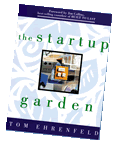
Just Managing: The Benefits of StubbornnessAll company builders must confront a handful of fundamental questions: What business are you in? What is your mission? Will you make or buy your product? Today, perhaps the most pressing questions are: What is your business model? How the heck are you going to make money - right now? Ben Narasin thinks he has some of those questions figured out. Narasin is CEO of Fashionmall.com (FASH), a fashion portal that gobbled up headlines earlier this summer when it purchased the remains of the now-defunct Boo.com - which burned through more than $200 million in venture funding in its attempt to build a pan-European branded site - for less than $1 million. I'll spare you another postmortem on Boo, whose excesses and mistakes have been detailed at length. Instead, I'll look at Fashionmall, whose long-term business model enabled it to acquire Boo's assets and play the tortoise to the hare. Indeed, Fashionmall appears to have far more staying power than the bright-burning company du jour. I got to know Narasin seven years ago when I wrote an article for Inc. Magazine titled "Face-Off." In that piece, Narasin compared the business model of his clothing company, Boston Prepatory, which outsourced everything from design to manufacturing in order to focus on building a brand, with Old Glory, a company with more of a soup-to-nuts model owned by his old friend and rival Laurence Levy. The core elements of those different business models are eerily relevant to the Internet Economy. At the time, Narasin argued the benefits of building a brand by keeping costs low, margins high, and avoiding heavy costs. Levy, on the other hand, preached the gospel of growth. He and his partner compensated for their low margins through hustle and rapid expansion. Their cost structure, which encompassed everything from design to manufacturing, forced them to constantly scramble for capital as they grew. Eventually Old Glory, which like Boston Prep was an Inc. 500 company, faded away. Narasin's company continued to be profitable (and does today) and ultimately provided him with the seed capital to launch Fashionmall six years ago. Today, Fashionmall is an oxymoron: a modest, publicly held Internet player. Describing his first six years running an Internet company, Narasin quips, "We got a disproportionate amount of no attention." His business model, Narasin says, is consistent with his vision of high margins and healthy profitability. "We are not an e-commerce player. We are selling pickaxes to gold miners. We sell traffic." Fashionmall makes money by referring Web surfers to the sites of the branded clothing companies it hosts. Fashionmall, like many publicly held Internet companies, is fashionably undervalued. After going public last spring at about $13 a share, the company is trading in the $2 range. Narasin is at a loss to explain this, considering that the $32 million in cash the company has in the bank is more than twice its market cap of roughly $15 million. The low stock price prompted the company to announce a buyback of as many as 1 million of its 7 million shares earlier this month. But Narasin is nonplussed by the low price, and he refuses to take any extraordinary measures to bolster Fashionmall's market cap. He says he's been through three market corrections already and will not budge from his vision. He says that soon after the company went public, analysts and investors scorned him for not spending money fast enough. They questioned his business savvy because he wasn't buying other companies or throwing big bucks at offline advertising. Today, having just bought one of the brightest-cum deadest-clothing stars, he feels his company's business model has been vindicated. My point is not to argue that Boo's spectacular flameout is proof that no company can make it as an e-retailer. That would make as much sense as arguing that because The Blair Witch Project was helped by its Internet site, all movies can become hits through a hip online presence. Instead, I'm simply illustrating that no single business model is generically correct for every business. To be so general is as fallacious as saying that venture capital is inherently evil, that short-term losses are crippling to all startups and that everybody should throw all their money at wireless.
People should choose a business model that works for their particular business. Narasin has endured by picking a sensible business model and sticking with it. He chose one that translated to the Internet, and he refused to switch gears according to prevailing market conditions. |
THE BOOK Read or print the Intro and Chapter 1. Read the book reviews at Inc and 1-800-CEO-READ. Read the publisher's press release. Buy this book from Amazon.com. Visit the companies that Tom discusses in the book Hear a recent lecture by Tom on the Startup Garden STARTUP KIT Buy my book and I will send you a worksheet and list of local and industry resources for your startup. Simply send me an email with your zip code and type of company and I will email you the free kit. Thanks! TOM'S WRITING Just Managing – articles that Tom wrote for The Industry Standard and some Business Articles written for Inc., Fortune Small Business, Harvard Management Update, and other places. RESOURCES Read about other books and web sites about starting your own business. |
| © 2001-2003 Tom Ehrenfeld | Site design by Tim Swan | |
